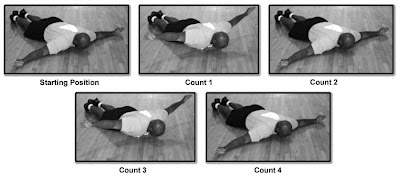EXERCISE
2: “T” RAISE
Purpose: This exercise develops
shoulder strength and stability (Figure 6-16).
Starting
Position:
Prone position with the head slightly elevated and in line with the spine. Feet
are together and toes are pointed to the rear. The arms remain on the ground
and are extended sideward at 90 degrees to the trunk, forming a “T”. The hands
are in a neutral position (perpendicular to the ground) with the thumbs and
fingers extended and joined
Cadence: SLOW
Count:
1.
Raise both arms 3-6 inches off the ground.
2.
Return to the starting position.
3.
Repeat count 1.
4.
Return to the starting position.
Figure
6-16. “ T ” raise.
Check
Points:
At the starting position,
tighten the abdominals to stabilize the trunk. The head is slightly elevated and
in line with the spine.
On counts 1 and 3, keep the
back generally straight with the head up.
Throughout the exercise,
the arms should be fully extended and the trunk and legs should also be in line.
Precaution: Keep the head slightly
elevated throughout the exercise and do not jerk the body into the up positions
on counts 1 and 3.

